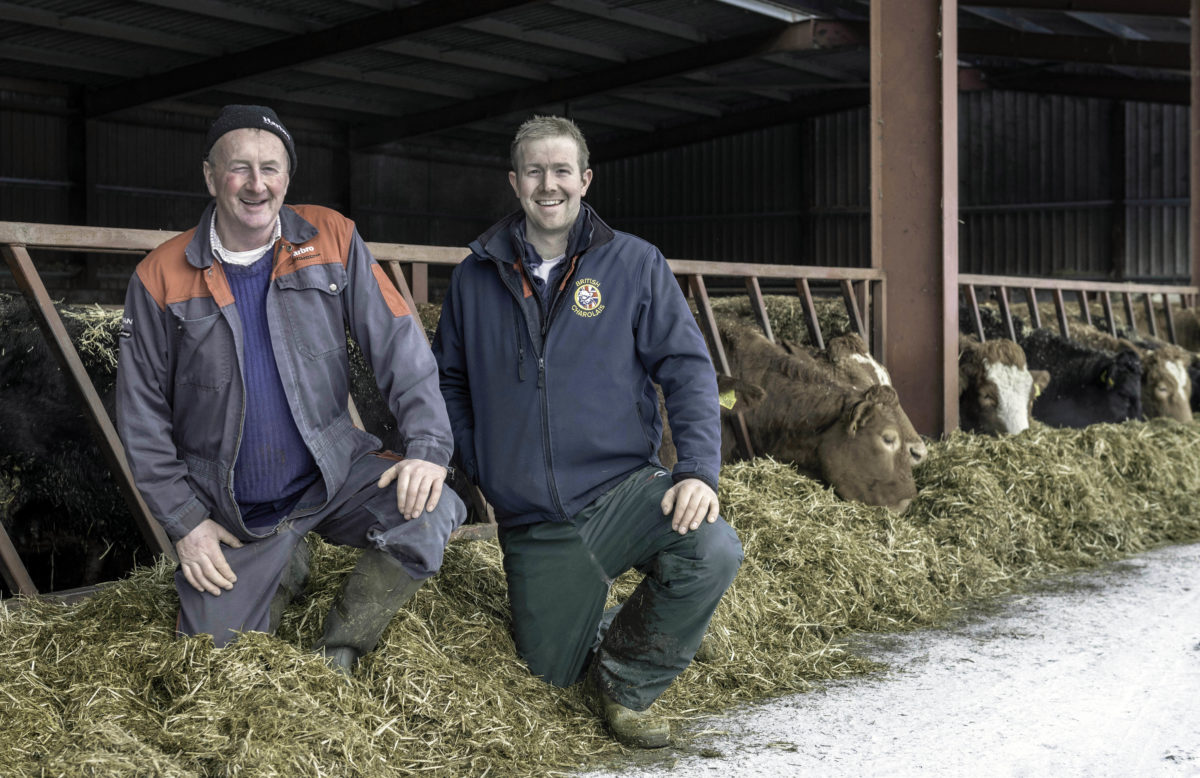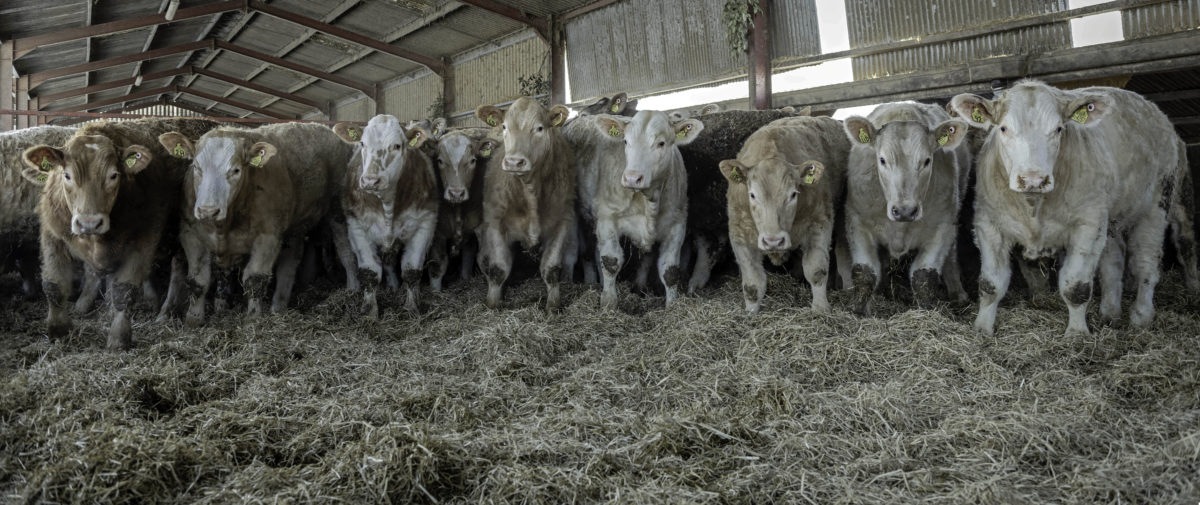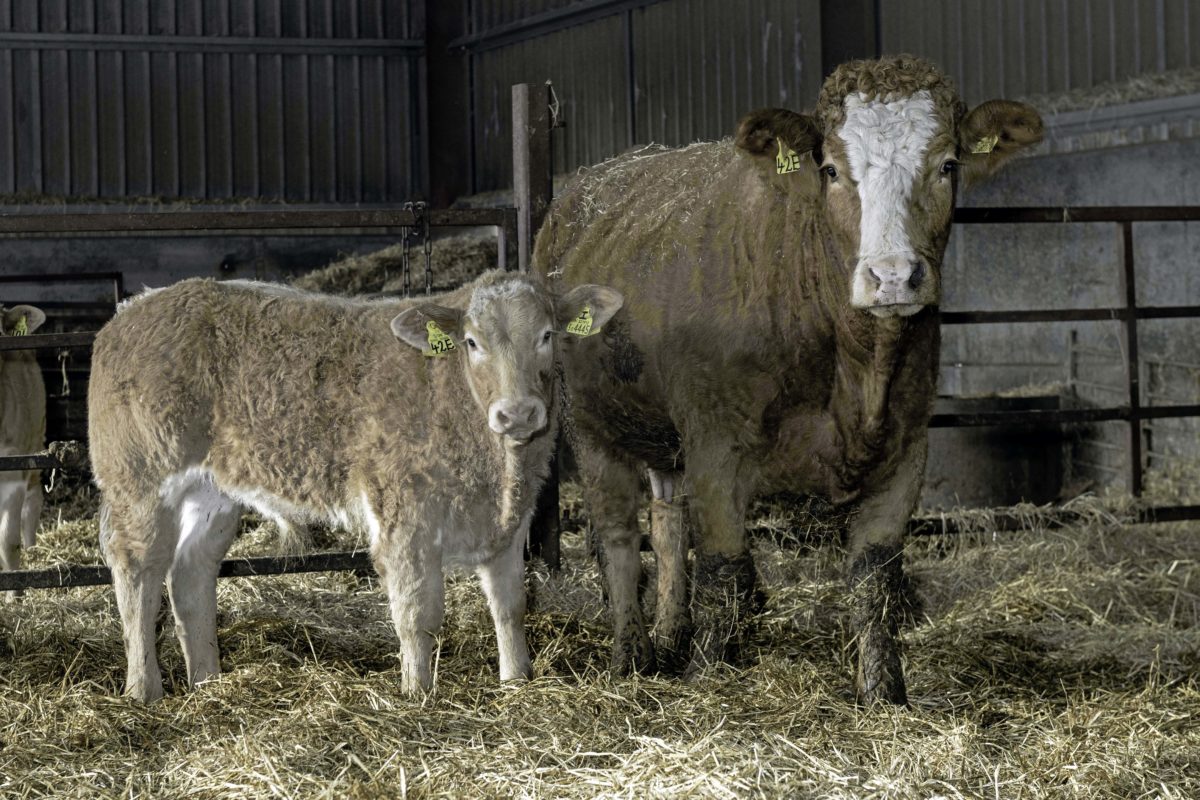Producing quality commercial livestock has long been the focus for the Gordon family from Huntly, Aberdeenshire, and is something they have strived to achieve each year. Katrina Macarthur reports.
Since the Gordon family came to the farm in 1879, Wellheads has become one of the best-known upland farms in the north east of Scotland, producing top Charolais cross cattle for the store ring and tremendous prime lambs sold direct to the abattoir.
John Gordon farms the 506-hectare (1,250-acre) unit in partnership with his wife Fiona and son Ewan, who is now the fifth-generation in the family business.
Situated at 198 metres (650 feet) above sea level, the farm rises to 375m (1,230ft) and includes 202ha (500 acres) of rotational grass, 121ha (300 acres) of improved grazing, 162ha (400 acres) of rough summer grazing and hill, as well as 20ha (50 acres) of trees.

History
John says: “My great grandfather took on the tenancy in 1897 and then my grandfather went on to purchase the farm in 1937.
“Throughout the 1980s, we managed to secure some more neighbouring land to Wellheads, allowing us to extend the one unit and increase stock numbers over the years.”
The beef enterprise includes 300 Limousin cross Simmental suckler cows which are all bulled to the Charolais to produce yearling store cattle sold through Aberdeen and Northern Marts’ Thainstone Centre.
All replacements are now bought-in as heifers with a calf at foot at breeding sales held at Thainstone, with the occasional few purchased at dispersal sales or privately.
The father and son duo prefer to breed with the cross-bred cows as pure Simmentals can be too big and heavy on the ground.
Ewan says: “The Limousin gives us an easily fleshed cow and the Simmental provides plenty of milk and good mothering attributes.

“We used to purchase some replacements as bulling heifers, but felt they were carried for a long time on the farm before we had a calf to sell and it proved costly to keep them when they were not being productive. We can now get the replacements bulled to the Charolais for their second calving while also having a strong calf to sell back through the ring.”
John adds that the new system has allowed them to operate a tight calving pattern, with one half of the herd calving from February 1 through to April 20 and the other half calving in autumn from mid-August to October 20.
“When calving heifers, it is a long calving period as you need to calve them a few weeks in front of the cows, so they have every chance to settle in-calf early as a second calver,” says John.
The first Charolais bull came to Wellheads in 1973 and has since remained the herd’s main terminal sire.
Sales
Not only does the progeny sell at premium prices in the sale ring, but the calves also sell to the same buyers each year.
John says: “The saying of cater to your market is very much a policy we follow because Charolais cross calves are undoubtedly the best sellers at Thainstone.
“These calves constantly average £50 to £60 more than other breeds and they sell to buyers who are looking for cattle which are well grown for their age and carry a moderate bit of condition for moving onto a finishing system.”
In recent years, spring-born steer calves sold in February have averaged 256p per kg or £1,126 at 440kg and spring-born heifer calves levelled at 251p/kg or £1,030 at 410kg.
A Limousin cross cow with an autumn-born Charolais cross calf at foot
From the autumn herd, male calves sold in September averaged 246p/kg or £1,163 at 473kg and heifer calves grossed 244p/kg or £1,064 at 435kg.
“The Charolais breed is ideally suited as you can get them to a good weight for age at one-year-old,” says Ewan.
“They go on and do well for the finishers who are taking them to 700kg liveweight or 400kg deadweight on a more concentrated cereal feed.”
John adds: “There is a perception that using a Charolais bull can lead to calving difficulties, but I believe it is down to good cow management, having them fit, not fat.
“It is also down to careful bull selection and matching the bull’s growth potential to the cow size. We do not like to buy an extreme bull but select one that is well shaped and fleshy.”
Stock bulls from the Elrick and Harestone herds have bred well at Wellheads and the duo has just recently purchased two young bulls from David MacKenzie’s Thurso herd at Insch.
Housing
The steading is well equipped to house all the cattle through winter, although 50 of the spring-calving cows are kept out on the hill until the turn of the year and are fed trailer loads of silage and straw.
Spring-born calves have access to creep feed from September onwards and the eldest calves are then weaned in mid-October.
The youngest calves are housed with their mothers on slats and are weaned in November, allowing them to settle in while reducing the risk of pneumonia.
“We put all of the spring-born calves onto slats once they are weaned and introduce them to a TMR of pit silage, straw, draff and treated barley,” says Ewan.
“About six weeks before sale day and when the bulls come out of the autumn herd, we swap the spring-born calves over to straw-bedded courts to clean them up and 100 of the autumn-calving cows and their calves go onto the slats.”

Feeding
The autumn calves are weaned on August 1 and put onto silage aftermath before being sold at Thainstone in September, with the youngest kept on until the turn of the year and sold at the mart’s anniversary sale.
Cows are moved onto bare grass field near to the steading and have access to straw and mineral buckets.
As they move closer to calving, batches of 20 to 30 cows are brought inside for calving. They are then returned outside with their calves, with the entire autumn herd housed on November 1 and fed on a total mixed ration.
The slats have been a great saving on straw for the Gordon family, especially when the farm is all in grass, with all straw being bought in the bout from local arable farmers.
John says: “I believe the gross margin per acre is far greater from an acre of grass than it is from an acre of barley. We have grown barley in the past but believe we get more than double the output from the grass than we would from the crops. The slats are a great saving, but we do still generate a lot of muck which does wonders for the grass and means we do not have to buy-in potash fertiliser.”
As well as a running a large-scale beef enterprise, the farm is home to 1,000 Scotch Mule ewes, 270 Mule ewe lambs for replacements and 30 pure Texel and Suffolk ewes which breed stock tups.
The Mule ewe lambs are bought-in from top consignors at both marts at Stirling and are lambed as hoggs in mid-April to Charollais and Texel tups.
These ewe lambs only run with the tup for one cycle to keep the lambing as compact as possible, with the aim of them rearing a single lamb only.
Lambing
All lambing takes place inside and commences with the pure ewes in February, followed on by the commercial flock from March 26 onwards.
The Mule ewes scan at 205 per cent to 210 per cent and the Gordons go on to achieve a good lambing percentage of at least 195 per cent each year.
“We have a very good survival rate because we lamb them all inside and someone is in the shed 24 hours a day,” says John.
“We adopt a triplet lamb onto a single bearing ewe but if we do not achieve this, one of the triplets is taken off the ewe and goes into the pet lamb pen to ensure all triplet lambs go on and thrive.
“Leaving the ewe with twins is much easier on her and it is so important to keep the ewe in good condition for the year ahead.”
Prime lambs
The first of the prime lambs are drawn from mid-June onwards and they head direct to Woodhead Brothers, Turriff, followed by 120 lambs every week throughout July, August and September.
All lambs are weaned from early August onto silage aftermaths and most are finished off the grass. The remaining lambs are put onto forage rape from mid-October, with all lambs on the farm being sold to the abattoir by Christmas.
Although Brexit may be in the back of their minds at Wellheads, the Gordon family certainly remains positive for the future and there is no doubting that the farm will be in safe hands with the next generation.
John says: “We are now early into Brexit and farming has been fantastic, with all classes of cattle and sheep trading at higher values. As a farmer, you have got to take the rough with the smooth and make the most of it, while being an eternal optimist at the same time.”
Farm facts
• The Gordon family has been farming at Wellheads for 142 years
• 506-hectare (1,250-acre) unit home to 300 suckler cows and 1,000 breeding ewes
• All replacements are bought-in
• Charolais cross stores are sold in large batches of 100 plus calves at Thainstone
• The herd is vaccinated for BVD and pneumonia
• More than 2,000 prime lambs sold to average £94 at 21.3kg deadweight
All field work is done in-house apart from forage harvesting silage
Categories: Commercial, News
Caylers Charolais – A pedigree update courtesy of Harbro » « ‘White Gold’ Female Sale – Coming 21 January 2022